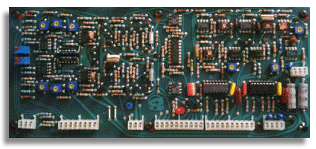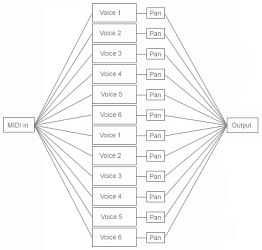This is the core technology of the OP-X PRO-II and also all lower synths of this series,
and even has been extended and improved for OP-X PRO-II. So what it is?
A normal digital synth achieves polyphony by just digitally cloning the exact same
algorithm into multiple voices which all are sounding exactly the same:

This may be convenient for synths that are concieved to deliver a digital kind of
sound as known from romplers and workstations. But it is by no means convenient to
emulate the lively and organic sound of early voltage controlled polyphonic synths.
But why?
Having a look at the inside of one of those early polyphonic analogsynths which are
famous for their full and lively sound you will notice that there are tons of
electronics, with hundreds or even thousands of electronic parts. The reason for
this is that each single voice in fact was a separate independent monosynth, sometimes
even each one on a separate exchangeable voiceboard, controlled by a global interface.
As an illustration a single voiceboard of an old OB-X:

Since electronic parts have individual tolerances those voices did never sound exactly
the same by default. This was compensated by a lot of trimpots, which had to be adjusted
for each voice individually to make them sound the same. This tuning procedure often
was done by a service technician. But temperature drifts and aging again did detune the
boards. So a re-tuning was needed from time to time. The pitch drift caused by temperature
could be compensated with an autotune function, which was a standard feature in those early voltage
controlled analog synths and had to be applied a while after switching on the device. So these
early analog synths as well as never were absolutely in tune, each voice had a slightly
different sound, since the fine settings of pitch, filter cutoff, envelope times, pulse
width and portamento times never were exactly the same in each individual voice.
From the todays's point of view exactly this imperfectness with all those slight detunings
did give those synths this beloved orgainic and lively sound. So to capture this soul a
digital synth has to emulate all of this, including the separate voices with individual
tolerances. Of course if would be great if the detunings could be easily controlled to
have all options open. This is what OP-X PRO-II offers. Have a look at its structure diagram:

As you can see the engine structure of OP-X PRO-II is nearly the same as the one of a real voltage
controlled polysynth. There's no digital voice cloning used to achieve polyphony. Each voice is a separate mono synth with completely independent
signal path and slightly deviating sound by default. The detunings however can be
globally controlled in every detail separatly for oscillators, filters, envelopes and
portamento times.
In OP-X PRO-II you now even can continuously blend between the tuned mode and the custom
detuning settings, calibrate the trimpots with a single mouse-click and involve or exclude
any voices of choice in the rotating voice allocation algorithm.
Learn more about the separate voice design in this video featuring OP-X PRO:

For more details have a look at the comprehensive pdf manual:

Feature Clips
Listen to some clips that show the sonic result of this special engine. The clips below
all have been done with the PROII_TESTPATCHES bank which is included in the free
demo version of OP-X PRO-II.
Oscillators:

Initpatch Brilliant
 Hard Sync
Hard Sync
 Sine FM
Sine FM
 Sine FM Bells
Sine FM Bells
 Pulse Modulation
Pulse Modulation
 Polyphonic Portamento
Polyphonic Portamento
Filters:

12dB SEM
 24dB Self Reso
24dB Self Reso
 Self Reso as Partial
Self Reso as Partial
 24dB Sweeps
24dB Sweeps
 Highpass
Highpass
 Bandpass
Bandpass
 Notch
Notch
 Mixed Notch w/ Reso
Mixed Notch w/ Reso
 Env to Filtermix HP to LP
Env to Filtermix HP to LP
 Env to Filtermix BP to LP
Env to Filtermix BP to LP
 LFO to Filtermix LP / Highpass
LFO to Filtermix LP / Highpass
 LFO to Filtermix LP / Banspass
LFO to Filtermix LP / Banspass
 Key Tracking 0%
Key Tracking 0%
 Key Tracking 50%
Key Tracking 50%
 Key Tracking 100%
Key Tracking 100%
Tuning:

Filters Tuned
 Filters Detuned
Filters Detuned
 Filters Custom Tuning
Filters Custom Tuning
 Oscillators Tuned
Oscillators Tuned
 Oscillators Detuned I
Oscillators Detuned I
 Oscillators Detuned II
Oscillators Detuned II
 Portamento Tuned
Portamento Tuned
 Portamento Custom Detuned
Portamento Custom Detuned
 Phase Tuned
Phase Tuned
 Phase Detuned
Phase Detuned
 Envelopes Tuned
Envelopes Tuned
 Envelopes Detuned
Envelopes Detuned